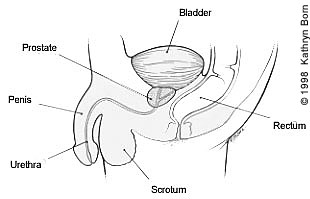
Am Fam Physician. 1998;57(7):1541-1542
See related article on prostate cancer.
What is the prostate gland?
The prostate gland is like a doughnut under your bladder. The urethra (the tube that carries urine out of your body) goes through the middle of the prostate gland. The prostate is about the size of a walnut (see the picture below). The prostate gland makes a fluid that carries sperm during ejaculation. As you get older, your prostate can become larger. It can also become stiff. This can cause urinary problems. This condition is called benign (noncancerous) enlargement, or benign prostatic hypertrophy. The prostate can also develop cancer.

What are the symptoms of prostate cancer?
Sometimes prostate cancer causes problems like those that occur with benign enlargement. These symptoms include slowing of the urinary stream, a feeling of not fully emptying the bladder after you urinate, waking several times in the night to urinate, and having blood in the urine. Sometimes weight loss or back pain can be the first sign of prostate cancer if the cancer has already spread into the body. In most men, however, prostate cancer causes few symptoms until it becomes very advanced.
How is prostate cancer diagnosed?
The usual ways to check for prostate cancer are a physical exam of the rectum (the area where the prostate can best be felt) and a blood test. In the rectal exam, your doctor puts a gloved, lubricated finger a few inches into your rectum to feel your prostate gland. Prostate cancer is suspected if any part of the gland feels hard. The PSA blood test is often used together with the rectal exam to find prostate cancer.
The PSA blood test checks the level of prostate-specific antigen (also called PSA) in your blood. A PSA level higher than 4 ng per mL might mean you have prostate cancer. The PSA level should be lower than 4 ng per mL in men who are 50 to 60 years of age. The normal PSA level in men 40 to 50 years of age is 2.5 ng per mL. However, some things other than cancer can also cause a mild increase in the PSA level. These things include recent sexual activity, recent urinary infection, prostate gland infection and benign prostate enlargement.
If your doctor thinks you have prostate cancer, based on the rectal exam and/or the PSA test, a biopsy is usually done to check the diagnosis. A biopsy takes about 15 minutes and usually doesn't cause pain. It's important to stop taking all aspirin and aspirin-like medicines for 10 days before you have the biopsy. To prevent infection, you will be given an antibiotic to take before the test.
An ultrasound machine takes pictures of the prostate gland before the biopsy. A small probe is put into your rectum, and the pictures of the prostate are taken. The doctor uses these pictures to guide the needle as it takes tissue samples for the biopsy. A doctor looks at the samples under a microscope to check for cancer cells. The side effects of the biopsy are usually mild. You might have a little blood in your urine and stool for a few days, and some rectal discomfort.
Should I be tested for prostate cancer?
The risk of getting prostate cancer is higher in some men than in others. If you are black or if you have a father, a brother or an uncle with prostate cancer, you should probably get a rectal exam and a PSA test every year, beginning when you are 40 years of age. Testing is also a good idea if you have any of the symptoms that can indicate cancer, such as those listed above.
Many forms of prostate cancer don't cause symptoms or shorten your life. Most cases of prostate cancer grow very slowly and tend to occur in older men. Heart disease, diabetes, stroke and pneumonia are greater threats to life in most men than prostate cancer. Simple things like quitting smoking, exercising regularly and eating low-fat foods may do more to prolong life than diagnosing and treating prostate cancer.
On the other hand, more than 40,000 men die every year from prostate cancer in the United States alone. Surgery and radiation treatments can cure prostate cancer if it's caught early, especially in middle-aged men. However, once the cancer has moved out of the prostate and into the body, no treatment can cure it. So it's good to find and treat prostate cancer before it spreads.